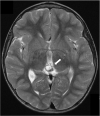Case report: Fluctuating tumor markers in a boy with gonadotropin-releasing hormone-independent precocious puberty induced by a pineal germ cell tumor
- PMID: 36081625
- PMCID: PMC9445167
- DOI: 10.3389/fped.2022.940656
Case report: Fluctuating tumor markers in a boy with gonadotropin-releasing hormone-independent precocious puberty induced by a pineal germ cell tumor
Abstract
GnRH-independent precocious puberty (GIPP) can be the presenting clinical picture experienced by patients with secreting germ cell tumor (GCT). Indeed, as luteinizing hormone (LH) and human chorionic gonadotropin (hCG) share identical α-subunits and similar β-subunits, an increased secretion of β-hCG may result in a precocious activation of Leydig cells. Though the co-occurrence of raised β-hCG levels and signs of precocious virilization usually prompts a complete oncological work-up, the diagnostic and therapeutic management of GCT-induced GIPP may be challenging. We report the case of a 6.2 year-old boy presenting with clinical and biochemical findings consistent with GIPP (discrepancy between overt virilization and pre-pubertal testicular volume, suppressed gonadotropins and remarkably raised testosterone). Brain imaging detected a bilobed cyst of the pineal gland, while serum and cerebrospinal baseline assessment initially ruled out raised alpha-fetoprotein or β-hCG levels. Nevertheless, a strict biochemical follow-up highlighted a fluctuant trend of tumor markers, with a more aggressive behavior and recurrent erections occurring as a result of unpredictable phases of raised testosterone and serum/cerebrospinal β-hCG, followed by sudden spontaneous decrease. Accordingly, a secreting pineal GCT was suspected. Given the fluctuating trend of tumor markers, surgery was initially kept on hold and a combined treatment with bicalutamide (androgen receptor blocker) and anastrozole (aromatase inhibitor) was undertaken in order to prevent the patient from experiencing further virilization and excessive bone age maturation. Subsequently, a progression in the size of the pineal tumor prompted surgical resection and a diagnosis of secreting GCT was histologically confirmed. Accordingly, the patient was started on adjuvant chemo- and radiotherapy. Antineoplastic treatment was followed by persistent and remarkable decrease of tumor markers and by a complete pubertal arrest. We reported the challenging diagnosis of a secreting pineal GCT in a patient with GIPP and a fluctuating trend of tumor markers, testosterone levels and associated clinical signs, hence prompting the indication for a systematic assessment and a strict monitoring whenever a patient with GnRH-independent precocious puberty shows clinical or radiological markers potentially consistent with a GCT.
Keywords: anastrozole; aromatase inhibitors; bicalutamide; chorionic gonadotropin; germ cell and embryonal neoplasms; pineal cyst; precocious puberty.
Copyright © 2022 Cattoni and Albanese.
Conflict of interest statement
The authors declare that the research was conducted in the absence of any commercial or financial relationships that could be construed as a potential conflict of interest.
Figures




Similar articles
-
Central precocious puberty secondary to peripheral precocious puberty due to a pineal germ cell tumor: a case and review of literature.BMC Endocr Disord. 2023 Oct 26;23(1):237. doi: 10.1186/s12902-023-01494-0. BMC Endocr Disord. 2023. PMID: 37884982 Free PMC article. Review.
-
Mediastinal Tumor in a Boy With GnRH-Independent Precocious Puberty and Fluctuating β-HCG Levels.JCEM Case Rep. 2024 Sep 27;2(10):luae169. doi: 10.1210/jcemcr/luae169. eCollection 2024 Oct. JCEM Case Rep. 2024. PMID: 39346011 Free PMC article.
-
Idiopathic gonadotropin-independent precocious puberty - is regular surveillance required?J Pediatr Endocrinol Metab. 2019 Apr 24;32(4):403-407. doi: 10.1515/jpem-2018-0419. J Pediatr Endocrinol Metab. 2019. PMID: 30849047
-
Rapidly Progressive Precocious Puberty With an Elevated Testosterone Level in a 5-Year-Old Boy With a β-Human Chorionic Gonadotropin-Secreting Intracranial Germ Cell Tumor in the Pineal Gland.AACE Clin Case Rep. 2022 Apr 25;8(4):174-178. doi: 10.1016/j.aace.2022.04.005. eCollection 2022 Jul-Aug. AACE Clin Case Rep. 2022. PMID: 35959087 Free PMC article.
-
Pathogenesis and management of abnormal puberty.Spec Top Endocrinol Metab. 1985;7:175-236. Spec Top Endocrinol Metab. 1985. PMID: 3914096 Review.
Cited by
-
Central precocious puberty secondary to peripheral precocious puberty due to a pineal germ cell tumor: a case and review of literature.BMC Endocr Disord. 2023 Oct 26;23(1):237. doi: 10.1186/s12902-023-01494-0. BMC Endocr Disord. 2023. PMID: 37884982 Free PMC article. Review.
-
Mediastinal Tumor in a Boy With GnRH-Independent Precocious Puberty and Fluctuating β-HCG Levels.JCEM Case Rep. 2024 Sep 27;2(10):luae169. doi: 10.1210/jcemcr/luae169. eCollection 2024 Oct. JCEM Case Rep. 2024. PMID: 39346011 Free PMC article.
References
Publication types
LinkOut - more resources
Full Text Sources

